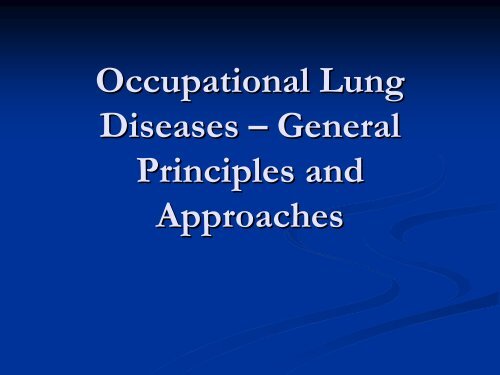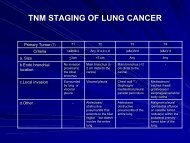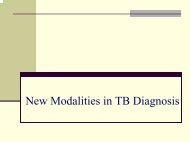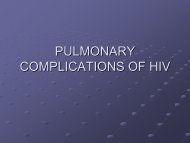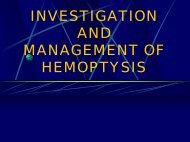Occupational Lung Diseases â General ... - The Lung Center
Occupational Lung Diseases â General ... - The Lung Center
Occupational Lung Diseases â General ... - The Lung Center
Create successful ePaper yourself
Turn your PDF publications into a flip-book with our unique Google optimized e-Paper software.
<strong>Occupational</strong> <strong>Lung</strong><br />
<strong>Diseases</strong> – <strong>General</strong><br />
Principles and<br />
Approaches
Introduction<br />
• Recent decades have seen a marked increase in concern<br />
about the adverse health effects of hazardous exposures<br />
in the workplace and elsewhere in the environment.<br />
• Endless array of hazardous substances in industrial and<br />
agriculture sectors.<br />
• <strong>The</strong> lung – with its extensive surface area, high blood<br />
flow and thin alveolar epithelium – is an important site<br />
of contact with these substances in the environment
Definitions<br />
• Damage to the lungs caused by dusts or fumes or noxious<br />
substances inhaled by the workers in certain specific occupations<br />
is known as “<strong>Occupational</strong> <strong>Lung</strong> <strong>Diseases</strong>”.<br />
• Pneumoconiosis – the accumulation of the dust in the lungs<br />
and the tissue reactions to its presence.<br />
• Dust – an aerosol composed of solid inanimate particles.
Importance of <strong>Occupational</strong> <strong>Lung</strong> <strong>Diseases</strong><br />
• Knowledge of cause may affect patient management and<br />
prognosis and may prevent further disease progression in the<br />
affected person.<br />
• Establishment of cause may have significant legal, financial and<br />
social implications for the patient.<br />
• <strong>The</strong> recognition of occupational and environmental risk factors<br />
can also have important public health and policy consequences.<br />
• <strong>Occupational</strong> and environmental lung diseases can also serve as<br />
important disease models.
Global burden<br />
• Health burden: 2 million work related death per year. #<br />
• Fatalities Attributable to work:<br />
Circulatory diseases 23%<br />
Respiratory diseases 7%<br />
Cancer 32%<br />
Contagious diseases 17%<br />
Accidents and violence 19%<br />
Other causes 2%<br />
• Tip of the iceberg : 160 million nonfatal diseases.<br />
# ILO Statistics 2002
WHO: World Health Report - Oct 2002<br />
• <strong>Occupational</strong> risk factors account for :<br />
Injuries 10%<br />
Back pain 37%<br />
Hearing loss 16%<br />
Cancer<br />
lung 10%<br />
leukemia 2%<br />
<strong>Lung</strong> diseases<br />
COPD 13%<br />
Asthma 11%<br />
Silicosis, Asbestosis, CWP 100%
Classification<br />
<strong>Occupational</strong> lung diseases can be classified according to<br />
several schemes.<br />
• Clinical presentation<br />
• Type of exposure to agent<br />
Organic dusts<br />
Inorganic dusts<br />
Metals<br />
Biological factors<br />
• Types of industry potentially associated with<br />
respiratory diseases
International Labour organization, Geneva.<br />
List of occupational <strong>Diseases</strong> (2002)<br />
• 1. <strong>Diseases</strong> caused by agents<br />
1.1 Chemical agents ( 32 items)<br />
1.2 Physical agents ( 8 items )<br />
1.3 Biological agents ( infectious and parasitic diseases<br />
contracted in an occupation where there is a particular<br />
risk of contamination )<br />
• 2. <strong>Diseases</strong> by target organ systems<br />
2.1 <strong>Occupational</strong> respiratory diseases<br />
2.2 <strong>Occupational</strong> skin diseases<br />
2.3 <strong>Occupational</strong> musculoskeletal disorders
• 3. <strong>Occupational</strong> cancer ( 15 items )<br />
(Asbestos, Benzidine and compounds, Bischloromethyl ether, chromium<br />
and compounds, coal tar, beta- naphthylamine, , Vinyl chloride, Benzene,<br />
Toxic nitro- and amino derivatives of benzene, Ionizing radiations, Tar,<br />
pitch bitumen, mineral oil, and related compounds, coke c<br />
oven emission,<br />
wood dust )<br />
• 4. Other diseases<br />
4.1 Miner’s s nystagmus
2.1 <strong>Occupational</strong> respiratory diseases<br />
• 2.1.1 Pneumoconioses caused by sclerogenic mineral dusts<br />
• 2.1.2 Bronchopulmonary disease caused by hard-metal dust<br />
• 2.1.3 Bronchopulmonary disease caused by cotton, flax, hemp or<br />
sisal dust<br />
• 2.1.4 <strong>Occupational</strong> asthma<br />
• 2.1.5 Extrinsic allergic alveolitis<br />
• 2.1.5 Siderosis<br />
• 2.1.6 Chronic obstructive pulmonary diseases<br />
• 2.1.7 <strong>Diseases</strong> caused by aluminium<br />
• 2.1.9 Upper airways disorders<br />
• 2.1.10 Any other respiratory disease not mentioned in the<br />
proceeding items caused by an agent where the casual<br />
relationship is established.
Basic principles of occupational lung diseases<br />
Certain principles apply broadly to the full range of<br />
occupational respiratory disorders<br />
• While a few environmental and occupational lung diseases may<br />
present with pathognomonic features, most are difficult to<br />
distinguish from disorders of nonenvironmental origin.<br />
• A given substance in the workplace or environment can cause<br />
more than one clinical or pathologic entity.
• <strong>The</strong> etiology of many lung diseases may be multifactorial and<br />
occupational factors may interact with other factors.<br />
• <strong>The</strong> dose of exposure is an important determinant of the<br />
proportion of people affected or the severity of disease.<br />
• Individual differences in susceptibility to exposures do exist.<br />
• <strong>The</strong> effects of a given occupational or environmental lung<br />
exposure occur after the exposure with a predictable latency<br />
interval
Pathogenesis<br />
<strong>The</strong> effects of an inhaled agent depend on many<br />
factors:<br />
• its physical and chemical properties<br />
• the susceptibility of the exposed person<br />
• the site of deposition within the bronchial tree
• Physical properties<br />
physical state (solid particulates, mist, vapor and gases )<br />
solubility<br />
size, shape and density<br />
concentration<br />
penetrability<br />
radioactivity
• Chemical properties<br />
alkalinity and acidity<br />
fibrogenicity<br />
antigenicity<br />
• Susceptibility of exposed person<br />
Integrity of local defense mechanisms<br />
Immunological status ( atopy, HLA type )<br />
Airway geometry
• Site of deposition<br />
When airborne particles come in contact with the wall of the<br />
conducting airway or a respiratory unit they do not become<br />
airborne again.<br />
Governs the lung response substantially<br />
Mechanisms of dust deposition:<br />
Sedimentation<br />
Inertial impaction<br />
Diffusion<br />
Interception<br />
Electrostatic precipitation
Size of particle<br />
mechanism of deposition<br />
site of deposition<br />
Large particles<br />
Sedimentation and<br />
Nose, trachea and<br />
(6 – 25 um) inertial impaction conducting airways<br />
Smaller particles<br />
(0.5 – 6um)<br />
Particles of < 1 um<br />
diffusion<br />
diffusion<br />
gas exchanging<br />
portions of lungs<br />
most of them<br />
exhaled out,<br />
Diagnostic criteria<br />
• <strong>The</strong> clinical presentation and workup are consistent<br />
with the diagnosis.<br />
• A casual relationship between the exposure and the<br />
diagnosed condition has been previously established<br />
or strongly suggested in the medical, epidemiologic or<br />
toxicologic literature.<br />
• <strong>The</strong>re is sufficient exposure to cause the disease.
• <strong>The</strong> details of the particular case, such as the temporal<br />
relationship between exposure and disease, are<br />
consistent with known information about the exposure-<br />
disease association.<br />
• <strong>The</strong>re is no other, more likely diagnosis.
Determination of casual relationship<br />
Three main types of information can be used to<br />
establish a casual relationship between an exposure and<br />
a respiratory condition:<br />
• Case series or reports<br />
• Epidemiologic studies<br />
• Toxicologic studies
Clinical approach to the patient<br />
<strong>The</strong>re are two important phases in the workup of any patient<br />
with a potential occupational or environmental lung disease.<br />
• 1. <strong>General</strong> approach: To define and characterize the nature and<br />
extent of the respiratory illness, regardless of the suspected<br />
origin.<br />
A detailed history<br />
Physical examination<br />
Appropriate diagnostic tools
• 2. To determine the extent to which the disease or symptom<br />
complex is caused or exacerbated by an exposure at work or in<br />
the environment.<br />
<strong>Occupational</strong> and environmental history – single most helpful<br />
tool in the diagnostic workup
<strong>Occupational</strong> and environmental history<br />
• Employment details<br />
Job title<br />
Type of industry and specific work<br />
Name of employer<br />
Years employed<br />
• Exposure information<br />
<strong>General</strong> description of job process and overall hygiene<br />
Materials wed by worker and others<br />
Specific workplace exposures<br />
Ventilation / exhaust system<br />
Use of respiratory protection<br />
Industrial hygiene informations provided by the employer to the employee.
• Environmental nonoccupational factors<br />
Smoking<br />
Diet<br />
Hobbies<br />
Pets<br />
• Details about past employments in chronological order<br />
• Other details<br />
Does the patient think symptoms / problem is related to anything at work<br />
Are other workers affected<br />
Work absenteeism<br />
Prior pulmonary problems and medications used
Physical examinations<br />
• <strong>General</strong>ly unrevealing about specific cause.<br />
• It is most helpful in ruling out nonoccupational causes<br />
of respiratory symptoms or diseases (cardiac problems<br />
or connective tissue disorders).
Diagnosis
Chest radiography<br />
• It is the most important diagnostic test for occupational<br />
lung disease.<br />
• Under certain circumstances, the chest radiograph can<br />
be unique or highly suggestive of an occupational<br />
disorder and may be sufficient, along with an<br />
appropriate exposure history, to establish a diagnosis.
Silicosis
Asbestosis
Limitations:<br />
• <strong>The</strong> chest radiographic findings can be nonspecific.<br />
• Conventional chest radiography is insensitive, missing<br />
as many as 10 to 15 percent of cases with pathologically<br />
documented disease.<br />
• Interpersonal variations
ILO – International Classification of radiographs of<br />
pneumoconiosis 1971.<br />
• To evaluate chest radiographs for epidemiologic<br />
studies, clinical evaluation and screening.<br />
• <strong>The</strong> system require a PA radiograph and comparison to<br />
a standard set of radiographs
ILO – International Classification of radiographs of<br />
pneumoconiosis 1971.<br />
• Film quality : Grades I to IV<br />
• Small opacities:<br />
round opacities:<br />
Irregular opacities:<br />
p (
ILO – International Classification of radiographs of<br />
pneumoconiosis 1971.<br />
Profusion:<br />
Category 0: small rounded opacities absent or less profuse than in<br />
category 1.<br />
Category 1: small rounded opacities definitely present but few in<br />
number.<br />
Category 2: small rounded opacities numerous. <strong>The</strong> normal lung<br />
markings are still visible.<br />
Category 3: small rounded opacities very numerous. <strong>The</strong> lung<br />
markings are partially or totally obscured.
ILO – International Classification of radiographs of<br />
pneumoconiosis 1971.<br />
• Large opacities:<br />
Category A : one or more large opacities not exceeding a<br />
combined diameter of 5 cm<br />
Category B : large opacities with combined diameter<br />
greater than 5 cm but does not exceed the equivalent of<br />
the right upper zone<br />
Category C : bigger than B
ILO – International Classification of radiographs of<br />
pneumoconiosis 1971.<br />
• Pleural Abnormalities:<br />
Location<br />
width<br />
extent<br />
degree of calcification<br />
• Other abnormal features: Symbols as prescribed by<br />
ILO.
Computed tomography<br />
• Conventional and HRCT scanning are highly sensitive<br />
for diagnosis of pleural diseases and useful for<br />
improved visualization of parenchymal abnormalities.<br />
• HRCT findings are usually non specific, but<br />
occasionally certain features and distribution pattern<br />
may suggest a specific cause and may help narrow the<br />
differential diagnosis.
Asbestosis
Chronic beryllium disease
Hypersensitivity pneumonitis (Farmer’s s <strong>Lung</strong>)
Physiological methods<br />
• <strong>The</strong> most important tool to assess functional<br />
respiratory status in patients with occupational lung<br />
disease.<br />
• <strong>General</strong>ly not specific but useful in<br />
Evaluating dyspnoea of various causes.<br />
Differentiating obstructive from restrictive defects.<br />
Assessing the degree of pulmonary impairment.
Methods<br />
• Spirometry<br />
• <strong>Lung</strong> volumes<br />
• Diffusing capacity<br />
• Methocholine challenge test<br />
• Preshift and postshift FEV1 measurements<br />
• Serial measurements of peak expiratory flow rates<br />
• Specific inhalation challenge tests
Cardiopulmonary exercise testing<br />
• Used to assess functional impairment and disease<br />
progression<br />
• Can help distinguish among cardiac, pulmonary and<br />
deconditioning causes of dyspnoea.<br />
• Not helpful in determining the specific origin of the<br />
lung diseases.
Pathologic examination<br />
Methods used to obtain specimens for<br />
pathologic examination<br />
• Bronchoscopy<br />
• Thoracoscopy<br />
• Open lung biopsy
Bronchoalveolar lavage<br />
• A predominance of lymphocytes suggests certain diagnoses such<br />
as sarcoidosis, hypersensitivity pneumonitis or beryllium disease<br />
(but is not by itself diagnostic).<br />
• <strong>The</strong> diagnosis of beryllium disease can be established with the<br />
finding of a positive lymphocyte transformation in the BAL cells<br />
of exposed patients.<br />
• Characteristic multinucleated giant cells may be seen in the BAL<br />
fluid of patients with hard-metal lung disease.
Transbronchial lung biopsies<br />
• TBLB yield only small tissue samples that may be adequate to<br />
diagnose disorders such as interstitial fibrosis, but are often<br />
unable to shed light on the reason for the pathology that is<br />
noted.<br />
• <strong>The</strong>y are most helpful in diagnosing granulomatous interstitial<br />
diseases such as sarcoidosis, beryllium disease and<br />
hypersensitivity pneumonitis and diffuse malignant processes.
Silicosis
Asbestosis
Chronic Beryllium Disease
Hard-metal disease
Hypersensitivity pneumonitis
Methods used to analyze dust content of lung tissue<br />
• Light microscopic evaluation with polarization<br />
• Radiographic fluorescence scanning electron microscopy<br />
• Energy dispersion radiographic spectroscopy
• Asbestos fibre seen under polarized light microscope
Limitations<br />
• Only particulates that are insoluble and retained in tissue at<br />
sufficient concentration will be detected.<br />
• <strong>The</strong>se methods can be tedious and there can be significant<br />
differences in results from different laboratories.<br />
• Most importantly, a positive finding documents biologically<br />
detectable exposure but does not demonstrate disease or<br />
establish a casual relationship.
Impact of diagnosis<br />
• For the clinician: important social, economic, legal<br />
and public health considerations.<br />
• For the patient: a profound impact on the work,<br />
income and social situation.
Prevention
• Prevention – central to the practice of occupational and<br />
environmental medicine.<br />
• Two main strategies:<br />
Primary prevention – removal or modification of<br />
hazardous risk or exposure before disease has occurred.<br />
Secondary prevention – early detection and prompt<br />
treatment of adverse effects of the exposure.
<strong>The</strong> various measures for the prevention of<br />
occupational diseases may be grouped as:<br />
• Medical measures<br />
• Engineering measures.
Medical measures<br />
• Pre-placement examination<br />
• Periodical examination<br />
• Medical and health care services<br />
• Notification<br />
• Supervision of working environment<br />
• Maintenance and analysis of records<br />
• Health education and counselling
Engineering measures<br />
• Design of building<br />
• Good housekeeping<br />
• Ventilation and exhaust systems<br />
• Mechanization<br />
• Substitution<br />
• Dust control<br />
• Enclosure / isolation<br />
• Protective devices<br />
• Environmental monitoring<br />
• Statistical monitoring<br />
• Research
Respirators<br />
• Mask respirator • Canister and cartridge Respirators
Respirators<br />
• Powered air purifying respirators • Self contained breathing apparatus
Ventilation and exhaust systems<br />
• Electrostatic filtration system • Fume extractor system
Impairment<br />
assessment
Recommended by OHSC, Mumbai.
Indian scenario
<strong>Occupational</strong> health in India<br />
• Past two decades have seen a rapid growth in the industrial and<br />
agricultural sector.<br />
• However, new economic policies and globalization of world<br />
trade have resulted in certain downfalls especially in industrial<br />
sector<br />
Shutdown of major industries<br />
Emerging small illegal production units<br />
• <strong>The</strong> diagnosis and follow-up of occupational diseases are to be<br />
looked at in this background where survival is at stake and<br />
workers’ morale for struggle is low
Major hurdles #<br />
• Poor training in OEH.<br />
• Bias of the professional class against the workers<br />
• Studies done on workers not available to anyone except to the<br />
select few who are conducting the study.<br />
• Medical certification not given to workers easily.<br />
• Disability certification, which is required for compensation, not<br />
understood by doctors and hence not given to workers.<br />
# Murlidhar.V, , Demystifying occupational and environmental health: experience in India, PRIA<br />
publication.
• Difficult access to the Internet due to shortage of resources.<br />
• All information being in English (some Latin and Greek), there<br />
is a serious difficulty in understanding the language.<br />
• Under funded workers insurance system (the ESI), and<br />
understaffed and poorly trained personnel and also general<br />
apathy among the staff of ESI scheme.<br />
• Lawyers ( pro-worker ) having poor knowledge of many<br />
progressive legislations in OEH.
Legislations<br />
• <strong>The</strong> Factories Act, 1948<br />
• <strong>The</strong> Employees’ State Insurance Act 1948<br />
• <strong>The</strong> Mines Act<br />
• <strong>The</strong> Plantation Act<br />
• <strong>The</strong> Minimum Wages Act<br />
• <strong>The</strong> Maternity Benefit Act
<strong>The</strong> Factories Act, 1948<br />
• <strong>The</strong> First Schedule – List of industries involving<br />
hazardous processes<br />
• <strong>The</strong> Second Schedule – Permissible levels of certain<br />
chemical substances in work environment<br />
• <strong>The</strong> third schedule – List of notifiable diseases
Notifiable occupational lung <strong>Diseases</strong>, <strong>The</strong> Factories<br />
Act 1948.<br />
Silicosis<br />
Asbestosis<br />
Coal miner’s s pneumoconiosis<br />
Byssinosis<br />
Berylliosis<br />
Various radiation induced diseases<br />
<strong>Occupational</strong> cancers<br />
Chrome ulcerations and sequalae<br />
Carbon monoxide poisoning<br />
Isocyanates poisoning
Organizations involved in occupational Health<br />
• Directorate <strong>General</strong>, Factory Inspection and Advisory<br />
Services, Ministry of Labour, Govt. of India<br />
• Central Labour institute, Mumbai<br />
• Regional Labour Institutes at Kanpur, Kolkata and<br />
Chennai.
Research Institutes<br />
• <strong>The</strong> Central Mining and Research Station, Dhanbad ( CSIR )<br />
• Industrial Toxicology Research Centre, Lucknow ( CSIR )<br />
• <strong>Occupational</strong> Health Research Institute, Ahmedabad ( ICMR )<br />
• National Environmental Engineering Research Institute, Nagpur<br />
• All India Institute of Hygiene and Public Health, Kolkata
All the best..


